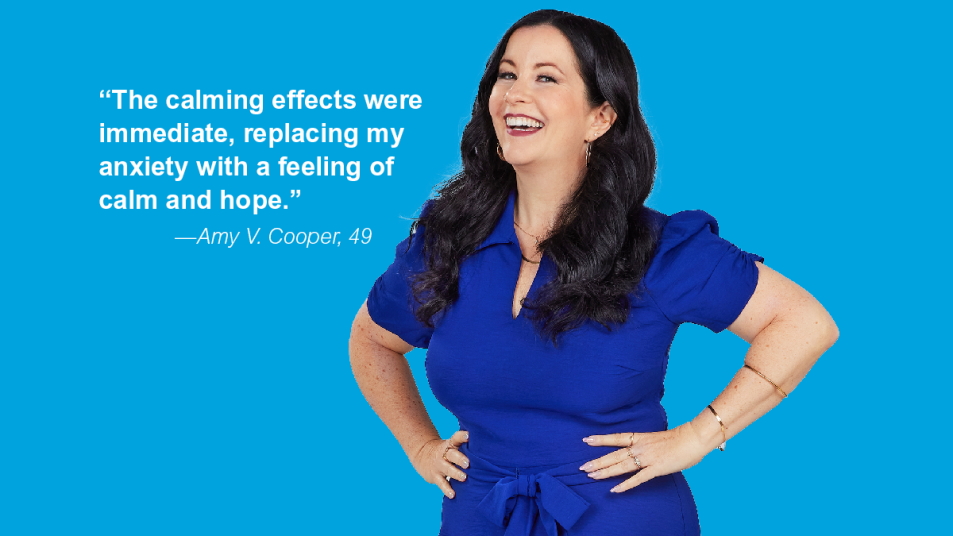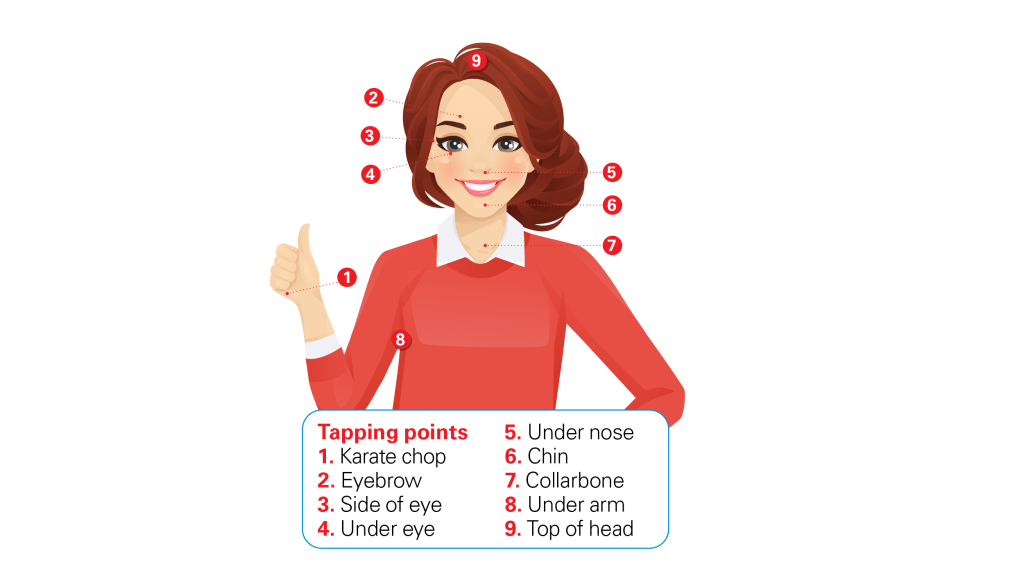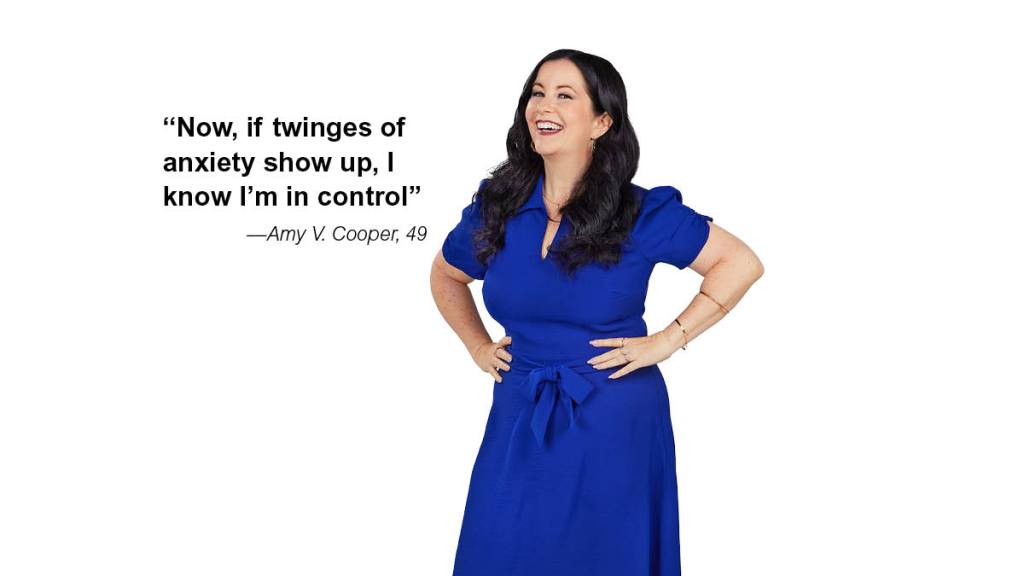Revolutionary ‘Tapping’ Technique Dials Down Anxiety By 67% in 10 Minutes, Says Study — MDs Weigh In on Whys and Hows
It may seem wacky, but studies show it's a powerful way to ease stress, boost mood and eliminate cravings!

Anxiety triggers are all around us these days: Feelings that range from fretful to downright panicky crop up when we balance our checkbooks, wait for the results of medical tests or worry when loved ones are late getting home. But when anxiety becomes a constant companion, it can prove overwhelming and exhausting. In fact, a study in the Journal of Psychiatric Research suggests out-of-control anxiety increases risks of fatigue, forgetfulness and other draining symptoms by 300%. Fortunately, help is literally at your fingertips: In a study published in the journal EXPLORE, a simple finger-tapping technique eased anxiety by 67% in only 10 minutes. And in real-life proof, Amy V. Cooper used tapping to overcome years of anxiety and exhaustion. Read on to learn about tapping for anxiety — and how it can work for you!
What is anxiety?
“Anxiety is a projection of fear that sends signals to the amygdala and hippocampus in the brain,” explains Melissa Hankins, MD, a Harvard-trained psychiatrist based in Seattle. And in some situations, anxiety can serve a valid purpose: It can help us seek safety when storms and other emergencies strike, spur us to see a doctor when we develop worrisome symptoms, and prod us to prepare for job interviews and work presentation.
But anxiety can take a draining toll over time. The reason, notes Dr. Hankins: It causes elevations in the stress hormone cortisol. And when anxiety is ongoing, constant cortisol surges put the brain in a ‘fight or flight’ state that triggers fatigue, brain fog and other symptoms. (Click through for expert advice on how to lower cortisol in the morning.) Plus, anxiety is a trigger of insomnia. And since lack of sleep makes anxiety even worse, women can become trapped in a draining vicious cycle.
Common causes of anxiety
None of us are strangers to anxiety. In fact, recent data from the US Census Bureau reveals 41% of women felt anxious during at least several days in the previous two weeks. And while causes of anxiety vary widely for person to person, experts have Identified a number of anxiety-inducers that are all too common. Among them:
Mounting stress
It’s no secret that the COVID-19 sent anxiety soaring: According to a study published in Mortality and Morbidity Weekly Report, the number of folks suffering from high levels of anxiety increased by 300% in the first year of the pandemic. But recent CDC data reveals rates of female anxiety are just as high now as they were during the months that lockdowns first started.
Trauma and loss
Traumatic events such as childhood abuse, life-threatening accidents and natural disasters can trigger longstanding anxiety. In a study in the journal European Psychiatry, emotional trauma increased the risk of suffering from an anxiety disorder by up to 360%. And not surprisingly, the loss of those we love causes anxiety to escalate. Researchers reporting in the American Journal of Psychiatry found tht the death of a loved one raised the odds of severe anxiety by as much as 965%.
Hormonal changes
Women over 50 are especially vulnerable to increased anxiety. In fact, a study in the journal Menopause determined that during perimenopause and menopause, risk of experiencing high levels of anxiety increased by up to 61%.
“Estrogen influences brain areas that regulate mood, emotions and other mental processes,” explains Taz Bhatia, MD, author of The Hormone Shift. “So when estrogen declines, we can lose its balancing effects.”
How to tell if you’re suffering from excess anxiety
Doctors can diagnose anxiety disorders with the aid of screening tests like the GAD-7 questionnaire (you can take the test here). Plus, they may conduct additional tests to rule out conditions such as thyroid problems and hormonal imbalances that can cause anxiety. But telltale symptoms can also yield valuable clues. So if you suffer from two or more of the following symptoms, an anxiety disorder could be to blame:
- Fatigue
- Trouble concentrating
- Excessive worry
- Feelings of impending fear or doom
- Restless
- Racing or irregular heartbeat
- Insomnia
- Shortness of breath
- Muscle tension
- Headaches
- Nausea or GI discomfort
Understanding tapping for anxiety
“Tapping is one of my favorite ways to ease stress and anxiety: You can feel its calming effects almost immediately,” says Dr. Taz. Also known as the Emotional Freedom Technique (EFT), it involves using your fingertips to tap specific acupressure points on the body. “This activates the parasympathetic nervous system, the branch of the nervous system that triggers the body’s rest and relaxation response,” Dr. Hankins says. (Click through to learn more about nervous system regulation and how it can help you fight stress.) Plus, tapping encourages a mindful acknowledgment and acceptance of anxious feelings that allows them to dissipate, she notes. And as Peta Stapleton, PhD, author of The Science Behind Tapping, points out, “Tapping reduces the stress hormone cortisol and lowers blood pressure. It can essentially change your biology!” Indeed, a study she conducted found people who participated in three EFT sessions lowered their cortisol levels by 43%.
A wealth of other research illustrates tapping’s anxiety-easing power. A report in the Journal of Evidence Based Integrative Medicine found the technique lowered anxiety by 40% in four days, while delivering a bevy of other benefits: Happiness increased by 31%, depression dropped by 32% and food cravings decreased by a whopping 74%.
What’s more, findings in the journal Psychotherapy reveal tapping’s ability to lower severe anxiety is comparable to cognitive behavioral therapy, a gold-standard treatment for anxiety. And tapping has even been shown to relieve the anxiety, depression, hostility and other symptoms associated with post-traumatic stress disorder (PTSD). In a study published in The Journal of Nervous and Mental Disease, 90% of veterans who suffered from PTSD no longer met clinical guidelines for the condition after completing six tapping sessions.
How to practice tapping for anxiety

Whenever stress mounts, Dr. Stapleton recommends this tapping sequence: To get the perks, you first need to identify the thing you want to change (like your anxiety or fatigue) and rate the distress it’s causing on a scale of 0 to 10. “Tapping works best when you are very specific,” says Dr. Stapleton. Next, state your problem while tapping the “karate chop” area of your hand (spot 1 above) three times. Then tap through the next eight points in order while repeating a reminder of your goal. Take a breath and re-rate your distress; repeat for 10 minutes.
Note: If self-taught tapping doesn’t deliver the results you need, Dr. Hankins advises working with a certified tapping coach who can help you fine-tune your technique. To find one in your area, check the directories available at eftinternational.org and energypsych.com.
For more tapping help, check out the video below of tapping expert Nick Ortner demonstrating his three-minute how-to, and visit his website, TheTappingSolution.com to download a free tapping app.
Tapping for anxiety success story: Amy V. Cooper

Will this excuse sound believable? Worried Amy V. Cooper , as exhaustion forced her to reschedule several meetings on a business trip. Debilitating anxiety that caused panic attacks, ruminating on feelings of fear and even flu-like symptoms of achiness and exhaustion made it nearly impossible for her to get sleep. Night after night, she would lie awake praying, not only for respite from her anxiety but the chance to get even a few hours of sleep so she would have energy throughout the day.
Amy knew something was wrong
“In 2017, I was about to step into the hotel elevator when I thought I was going to faint,” recalls Amy. “I started sweating, my heart was racing and my knees felt weak. I had been battling insomnia for a while that I assumed was due to the typical business of life, and thought maybe I was so exhausted that I nearly collapsed. But I started having periods of feeling panicky more often. Worried something might be seriously wrong, I saw the doctor, who reassured me I didn’t have a serious health issue like a brain tumor. But I was dumbfounded as he explained anxiety was causing my mood swings, insomnia and panicky feelings.
“I followed her advice to first tackle the insomnia and took prescription sleep medicine that helped me get some sleep, but always left me feeling extremely groggy and out of it for several hours into my morning. Ironically, that tiredness felt similar to the fatigue I battled after a night of tossing and turning.
“My decision to stop taking the sleep medicine meant my insomnia and anxiety fed each other: The anxiety made it hard to sleep, but the less sleep I got, the worse my anxiety became. My symptoms seeped into every part of my life greatly influencing my mood, stealing my ability to exercise and socialize and even to travel and maintain my performance at work. there were times when I felt like I had to reschedule appointments because I was so exhausted or panic-stricken.
“Over the next few years, I saw several doctors who prescribed a variety of Band-Aid remedies that treated the symptoms instead of their cause, including hormone replacement, more sleep medications, antidepressants and supplements. But the medications made me feel like a zombie and the others were only temporary fixes. Feeling like I was out of treatments, I turned to hypnosis, coaching, meditation, acupuncture and breath work, as well as taking magnesium and occasionally ashwagandha, along with trying to maintain an exercise routine. These were moderately effective at easing symptoms for a little but didn’t work as a long-term remedy.
How tapping for anxiety turned Amy’s life around
“Desperate to find a way to reclaim my life, I began researching natural ways to ease anxiety and discovered YouTube videos on EFT tpping by Gala Darling. I read how tapping may reduce stress and anxiety, lessen cravings and help resolve fears. What do I have to lose, I thought and decided to give it a try despite being a bit skeptical.
“The next morning, even though I didn’t really believe it would have any effect on my life, I followed Gala’s video and started tapping on the side of my hand, between the pinkie and the wrist, on top of my head and above my eyebrows for about 5 minutes. As I did, I set positive intentions, telling myself, ‘Today I am showing up fully and authentically. I am present and focused. I take care of my body.’
“That day, I used tapping at the first twinge of feeling overwhelmed by stress or panic. The calming effects were immediate, replacing my anxiety with a feeling of calm and hope that I might finally break the anxiety/insomnia cycle I had been stuck in. After a period of practicing tapping, I was able to use it to help me fall asleep more quickly, especially when waking up in the middle of the night.
“Thrilled to clean out my medicine cabinet, I made tapping part of my daily routine, tapping for 5 to 15 minutes per session every morning and throughout the day as needed.
“It worked so well for me that I became certified as a practitioner in EFT tapping to prevent others from suffering insomnia, panic and anxiety the way I did. I feel so much better now and am thrilled to feel in control of my life and capable of tackling anything that comes my way because if twinges of anxiety show up, I know I’m in control.”
This content is not a substitute for professional medical advice or diagnosis. Always consult your physician before pursuing any treatment plan.
For more stories on how to ease stress and anxiety, keep reading!
Ever Feel So Stressed It Seems Like The World Is Spinning? Why It Happens and 6 Ways To Instantly Feel Calmer
“Stimulating My Vagus Nerve With This Little Machine Healed My Anxiety!”
Tough Day? A Dramatic Sigh Could Be the Stress Reliever You’re Looking For













